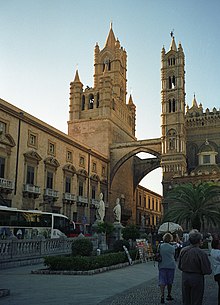Museo Diocesano di Palermo
The Museo Diocesano di Palermo (Diocesan Museum of Palermo) is a museum in the city of Palermo , Sicily . The museum mainly shows works of sacred art from the 12th to 19th centuries. It is housed in the Archbishop's Palace .
History and location
The museum was founded in 1927 by Archbishop Alessandro Lualdi . After being closed for decades for restoration work and archaeological investigations (1991–1992, 1999–2000), the museum has been open to the public again since December 22, 2003. It currently occupies two floors (raised ground floor and basement) of the wing of the Archbishop's Palace on Via Matteo Bonello opposite the forecourt of the Cathedral of Palermo . An extension to the upper floor (piano nobile) of this grand piano is also planned. The entrance to the museum is roughly in the middle of the facade.
tour
From the entrance, the circular path leads first on the ground floor to the left through two rooms with paintings from the 12th to 16th centuries. These are predominantly pictures of Mary by anonymous masters. The oldest piece is the Vergine Odigitria , also known as Madonna della Perla , which was painted in 1171 for Santa Maria del Cancelliere, a nunnery founded by the Norman Vice Chancellor Matheus . In the pictures from the 15th century, influences of Tuscan painting can be seen.
From the last room, which still has a three-part Gothic window from the first building phase of the palace, it goes into the basement. Remnants of walls from the Punic period to the Middle Ages have been excavated there. Part of the excavations can also be seen from the courtyard of the palace. The urban development of Palermo is illustrated by means of display boards.
The works of art in the basement are mainly sculptures from the 15th to 18th centuries. One room is dedicated to the school of Antonello Gagini and his son Vincenzo Gaggini , which dominated Sicily in the 16th century. Many of the Gagini figures on display here come from the cathedral's marble platform , which was removed as part of the renovation work in the 18th century.
Around the place of the west tower of the cathedral, a staircase leads back to the ground floor. Other rooms with paintings from the 16th to 19th centuries follow. One of the rooms below is dedicated to old cityscapes of Palermo, while another room mainly shows works by Pietro Novelli and his school.
In the last room, before you get back to the entrance, you will find paintings and cult objects from the 17th and 18th centuries, such as B. Chalices, crosses, monstrances, reliquaries and vestments.
literature
- Filippo Pottino, Il Museo Diocesano di Palermo , (guida sintetica del museo), Stabilimento tipo-litografico IRES, Palermo 1969.
- Capolavori d'arte del Museo Diocesano. Ex sacris imaginibus magnum fructum , a cura di Maria Concetta Di Natale, Edizioni O.DI.PA., Palermo 1998.
- Decorative art in the Museo Diocesano. Dalla città al museo dal museo alla città , a cura di Maria Concetta Di Natale, Edizioni O.DI.PA., Palermo 1999.
Web links
Coordinates: 38 ° 6 ′ 49.4 ″ N , 13 ° 21 ′ 19.3 ″ E

